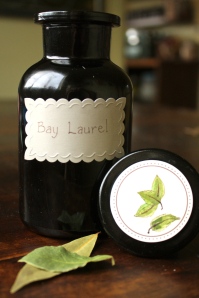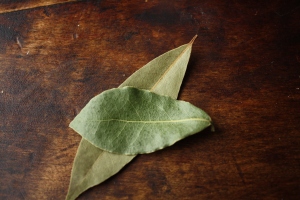My favourite part of our kitchen, since our renovation, is the shelf that cradles my collection of spices and herbs. I can travel the world just by inhaling the heady aromas enclosed in the purple apothecary jars that preserve the flavourful treasures within. I’d like to share some of these seasonings and why they make me so giddy!
The scent of Bay Leaf always takes me back to the California coast where groves of California Bay Laurel trees fill the air with a heady scent as the trees sway in the constant ocean breeze. My other strong scent associated memories of California are the night-blooming jasmine in Napa and the ever-present scent of Ranch Dressing in the capital city of garlic, Gilroy. While the leaves of the California Bay Laurel can be used for seasoning dishes, the more subtly flavoured Bay Laurel that is native to the Mediterranean is more commonly used in cooking and more widely available. There are also other varieties of Laurel trees outside of Europe that are used in local cuisines, including: Indian Bay Leaf, Indonesian Bay Leaf, West Indian Bay Leaf and Mexican Bay Leaf. Each has a different flavour profile, but they all have a similar appearance.
While dried Bay Leaf can be purchased at any grocery store, it’s always better to dry the fresh leaves yourself for maximum flavour. While I have never been lucky enough to have my own Bay Laurel, I have been the recipient of branches from generous friends and neighbours who have. My most recent bough was overflow from a bushel given to my mother. The fresh leaves are quite mild and need to be dried for several weeks to reach their full flavour capacity. I like to use the newly dried leaves as I find the flavour is more buttery and rich. In the photo below, the leaf on top is one from the branch above and the bottom leaf was purchased.
I use Bay Leaf in almost every soup and sauce that I make (including Cranberry Sauce), as it works well with most other spices and herbs adding a slightly floral complexity. I always use whole leaves and fish them out near the end as they are inedible unless ground to a fine powder. You can also place the smaller pieces in a tea ball or muslin bag, which can also be improvised with cheese cloth. As with many herbs and spices, bay leaves have long been used for their medicinal properties, but the leaves of the laurel tree are most often associated with the laurel wreaths worn by Olympians in Ancient Greece and victors of war in Ancient Rome. Bay Leaf is always a winner in my books and I will continue to rest on my laurels when I’m looking to create a more complex flavour.
 What dishes just wouldn’t be the same without a hint of bay leaf?
What dishes just wouldn’t be the same without a hint of bay leaf?
Related articles
- Bay Leaf Know Your Herbs and Spices (foodiefriendsfridaydailydish.com)
- Bay Leaf (sagemooncottage.wordpress.com)
- All I need…. is a bay leaf (wildflowerramblings.wordpress.com)
- Top 10 Favorite Herbs and Spices (marksdailyapple.com)





How wonderful for you, Julia to have fresh bay leaves! Thanks for stopping by and linking to Foodie Friends Friday Daily Dish! Cindy from http://cindysrecipesandwritings.com
It does make me feel pretty special! 🙂
I love your spice collection!! And I’d love to try growing my own bay leaves — I’ve never thought about it — I’m going to be making my own vanilla extract soon 🙂 Thanks for linking to me.
Thanks, it always makes me smile to see all the flavour options at my fingertips.
I have been making my own vanilla extract with Tahitian vanilla beans and vodka for years and would never go back to the commercial stuff! I’ll have to share that soon 🙂